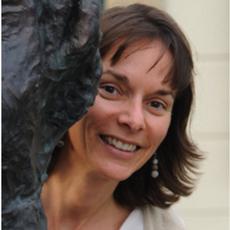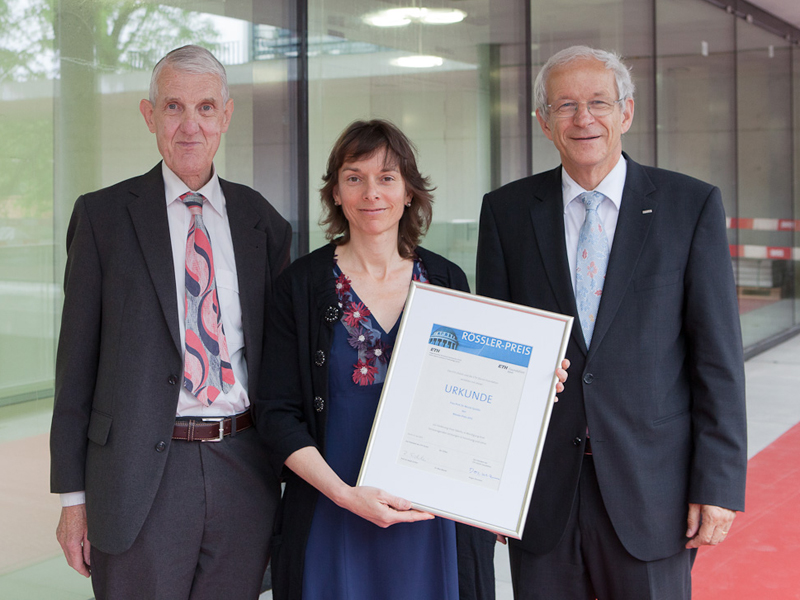“Figuring out why electrons do what they do!”
Nicola Spaldin, Professor of Materials Theory at ETH Zurich’s Department of Materials, receives the Max Rössler Prize, which includes CHF 200,000 in prize money. The passionate materials researcher drums up enthusiasm for her field in an interview.

Your long list
of awards and honours is becoming longer: yesterday you received the Max Rössler
Prize. What does this prize mean to you?
What makes this award so significant is that it is awarded
by a home institution to its researchers. I think it is very special when your
home institution recognizes you, much more so than receiving recognition from
outside. It’s also tremendously gratifying because I have such talented
colleagues doing such interesting research that I can’t imagine how the
Schulleitung was able to choose one person. So it is a little bit embarrassing
(laughs) to be singled out. But it is also very flattering because there is so
much interesting work going on at ETH Zurich.
So it is a
special honour for you?
Yes, of course!
You did a
bachelor’s in chemistry and geology at Cambridge University and a PhD in
chemistry at the University of California, Berkeley, before becoming a
physicist. And today you are a professor of materials science. How did this
happen?
That’s a good question. In materials science we often
debate what materials science actually is. What defines it and sets it apart
from chemistry and physics, for example? One of the main distinctions is that
it is very interdisciplinary; it draws on all of the other sciences and all
aspects of engineering. What I do is very much at the boundary between
theoretical and solid-state chemistry; condensed matter and mineral physics. It
all comes together in materials science.
And in science
your heart beats for…
That’s probably the same for every professor: as far
as I’m concerned, my own research field – materials theory – is the most
interesting thing in the world! ETH-Zurich professors have tremendous freedom
in their research, so we all work on whatever is the most interesting and
important to us.
How would you
describe your research in a nutshell?
My group and I are designing new materials with
combined multiple functionalities that tend to either compete with or
complement each other to enhance the behaviour of the material. Since our
expertise lies in materials theory, we perform calculations to understand and
explain such properties in existing materials, then use the knowledge we’ve
developed to design new materials in the computer. Historically, we’ve worked
with experimental groups to make and characterize the materials and we’re
actually building our own synthesis laboratory at ETH Zurich, which is a new
direction and a big adventure for me!
Your research
field sounds very fundamental.
Yes. Much of what we are doing is indeed very
fundamental. We’re interested in making new materials with properties or
combinations of properties that nobody has even thought up yet; materials with
entirely new behaviours. And we would like to discover completely new
functions, new ways in which atoms and electrons respond to light, temperature
or magnetic fields, for example. Since we don’t know what these functions will
be yet, we can’t say if or where they will find an application!
So at the
moment your research has no practical application?
In our group, we have a balance between very long-term
fundamental research and research on materials which are relevant for devices
and technologies in the short or medium term. One example of our more applied
work is so-called magneto-electric
materials. Magnetic materials are tremendously important technologically. In
your car, for example, you have more than 200 magnets: in motors, sensors,
actuators and various instruments. At the moment, each magnet can only be
addressed using a magnetic field. And to create a magnetic field, you need a wire
coil with current flowing through it, which is bulky, heavy and uses a lot of
power. In our magneto-electric materials, we engineer cross-couplings between
the magnetic and electrical properties. So in principal you could reproduce all
of our present-day magnetic technologies, but with electric fields to do the
tuning and switching on and off. This will vastly improve energy saving and
miniaturization.
In your recent
work, you have been collaborating with both high-energy physicists and
cosmologists. Where do materials and cosmology research meet?
Cosmologists would like to find out what happened in
the early universe just after the Big Bang, but it’s very difficult for them to
test their theories because they can’t recreate the Big Bang in the lab! We’ve
discovered that one of our magneto-electric materials has similar symmetry
properties to those proposed for the early universe, so we’ve been able to
design laboratory experiments that reproduce aspects of Big Bang physics. This
has been one of the most fun projects I have ever worked on and a discovery
that was completely unexpected when we began our work on magneto-electrics!
With the high-energy physicists, we are designing new magneto-electric
materials for precision measurements of fundamental properties of the electron,
which have implications for high-energy physics theories such as
super-symmetry.
What is the
most fascinating thing about your research for you?
Figuring out why electrons do what they do! We
understand very well why one electron behaves as it does and even how two
electrons interact with each other. But why, when you have lots of electrons
together in a solid, do their interactions combine to give us exotic properties
such as superconductivity or novel types of magnetism? We don’t understand that
at all. What is it about the collective
behaviour of these little electric particles that makes them so peculiar? For
me, this is the most interesting fundamental question.
What is the
most challenging thing for you as a scientist?
Probably the same challenge everybody faces these days:
not having enough time to do all the things I would like to and do them well,
spend more time with my students and postdoctoral researchers, do my research,
teach effectively, think… Sometimes it would be nice to go home and pretend I
have a social life, too (laughs).
Not only have
you got a lot of research interests; you are also a mountain climber, skier,
clarinettist, pianist and much more.
Actually, the piano in my office is for playing
chamber music, which I enjoy tremendously, but definitely not with me playing
the piano – that would be painful for the other players and listeners! In
chamber music, I play the clarinet.
Where do you find
the time for all these activities?
That’s a good question… I don’t have much down time.
Perhaps the hardest thing is to balance the various professional demands I
mentioned earlier with all the trips to conferences, research collaborations
and administrative committees. I’m happiest when I get to stay home at ETH Zurich
and discuss science with my team.
You have a
team of fifteen scientists. Is it an interdisciplinary team?
Very much so. The majority are probably from physics
and materials science, but we also have people from chemistry and mathematics.
Last but not
least: what will you use the prize money for?
At ETH Zurich, our core research is very well funded –
by ETH Zurich and external agencies such as the National Science Foundation and
the European Research Council. So rather than starting a new project which I
could fund from one of these sources, I plan to use the Rössler Prize as a
“rapid response” fund for new directions where we want to do something really
quickly; when we have a new idea that we’d like to work on immediately and need
a special piece of equipment or new personnel there and then. I also plan to
host small meetings to which we will invite researchers from related fields for
a couple of days of intense brain storming with the group. We’ll discuss new
research directions and think about what needs to be done to move the field
forward. I’d also like to persuade some of the visitors to stay on and spend a
sabbatical at ETH Zurich to help boost the new collaborations. Maybe this will
also save me some time!
Profile
British scientist Nicola Spaldin studied geology and
chemistry at the University of Cambridge in Great Britain before completing a
PhD in chemistry at the University of California, Berkeley, in 1996. After a
stint as a postdoctoral student at Yale University, New Haven, she took up an
assistant professorship (1997 – 2001) and associate professorship (2001 – 2006)
at the University of California’s Department of Materials in Santa Barbara and in
2006 she was made a full professor before joining
ETH Zurich in 2011.
Max Rössler Prize
In 2007 mathematician and ETH-Zurich graduate Dr. Max Rössler donated CHF ten million to the ETH-Zurich Foundation. The prize promotes a particularly promising young ETH-Zurich professor in the expansion phase of his or her research career with a view to boosting the potential of a scientist in the field of natural sciences and technology. So far, structural biologist Nenad Ban, earth scientist Gerald Haug and physicist Andreas Wallraff have won the award, which includes CHF 200,000 in prize money.








READER COMMENTS